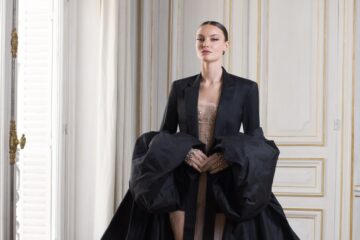Greatness is in the Process – Christian Dior Exhibition
The Christian Dior brand has become one of the most iconic names in the fashion world. This November, the ROM will provide a glimpse into the work that went into making the Dior name what it is today.
There are few dresses that can be worn virtually anywhere, anytime. There are even fewer that can be deemed “essential.” Christian Dior’s “Pampelune” meets both criteria. The fine black wool dress is something you could see a woman wearing at a wedding or a wake. And yet, the fitted waist and sleek skirt also provide a casual, unceremonious feeling, enabling the dress to be worn in an informal setting. It’s the best of both worlds.
“It’s one of these masterpieces of engineering that looks like a simple black dress, but is not at all,” says Dr. Alexandra Palmer, senior curator at the Royal Ontario Museum (ROM) and author of the award-winning book, Dior: A New Look, A New Enterprise. “It’s the kind of design, experimentation and unbelievable [man-hours] put into it, with very difficult detailing.”
This garment, along with 40 other Dior designs, will be on display at the ROM’s Patricia Harris Gallery of Textiles & Costume from November 2017 until March 2018, as part of the museum’s new Christian Dior exhibit. The exhibit — celebrating the House of Dior’s 70th anniversary — will feature classic Dior items from one of the ROM’s most beloved and exclusive collections, which focuses on the incipient stages and early designs of Christian Dior. The exhibition will look at Dior’s great creations and how they revitalized Paris’s haute couture industry in the post-Second World War era, specifically 1947 to 1957. Dior passed away in 1957.
For Dr. Palmer, the exhibition’s curator, the showcase will examine the process of Dior’s works coming to fruition. “This looks specifically at the house, the creations of Monsieur Dior — how they were made, what it was about the clothes themselves that made women want them and made women look beautiful in them, that made buyers and manufacturers need to have them in hand in order to copy and make versions of them,” she says.
Dr. Palmer recently mentioned in a ROM press release that Dior’s postwar fashion is a testament to the work of numerous industries and artisans, who made the “extraordinary” sequins, embroideries, ribbons and beads that Dior integrated into his dresses. He did so with the assistance of his creative seamstresses, pattern makers and tailors. “This exhibition focuses very much on the makers and [those] who made things (i.e., the ateliers) — what it was about the clothes that made women feel so elegant and how that was achieved through the way the clothes were designed and constructed,” says Dr. Palmer.
The exhibition is thematically organized by clothing types. The Day section consists of coats, suits and day dresses; Late Afternoon to Early Evening contains a display of cocktail and dinner dresses; and the Grand Occasion portion features ball gowns and formal gowns.
Some of the items that will be on display at the ROM include the silk-satin “Rose France” evening dress and the three-piece, wool-crepe “Chandernagor” dancing dress. “I think because [the exhibition] is about design and how things are made, when you start pulling them apart and looking, it’s absolutely fantastic [and] difficult,” says Dr. Palmer. “[It’s] an endless jigsaw puzzle of how to make a sleeve, a jacket — all this stuff. There’s endless variations.”
Interview By Rebecca Alberico
photos courtesy of royal ontario museum



















































































No Comment